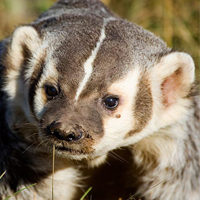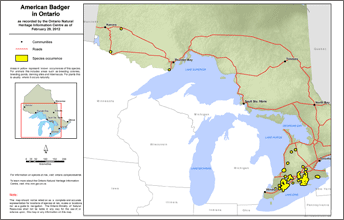American badger
Scientific name: Taxidea taxus


Cover photos credit: JD Taylor
Status
Endangered
“Endangered” means the species lives in the wild in Ontario but is facing imminent extinction or extirpation.
Date added to the Species at Risk in Ontario List
The American Badger was already assessed as endangered when the Endangered Species Act took effect in 2008. In 2015, the population was separated into two, with both the Southwestern population and the Northwestern population listed as endangered.
Read the assessment report (PDF)
What it looks like
The American Badger is a short, sturdy member of the weasel (or mustelid) family. It is the only type of badger that lives in North America. Badgers have the long body, short legs, and scent glands characteristic of the weasel family.
The American Badger is gray, with dark legs and bold black and white stripes on its head and face. Badgers are built for digging. Badgers have long strong claws and a streamlined skull enabling them to create these dens and dig prey out of burrows. Badgers also have a second (transparent) eyelid which can be closed to protect the badger’s eye from dirt.
Different subspecies of badgers have slight differences in appearance. The Southwestern subspecies in Ontario is jacksoni, which tends to be darker, tawnier and slightly smaller than the taxus subspecies found in the Northwest.
Where it lives
In Ontario, badgers are found in a variety of habitats, such as tall grass prairie, sand barrens and farmland.
These habitats provide badgers with small prey, including groundhogs, rabbits and small rodents. Since badgers are primarily nocturnal and quite wary of people, not many people are fortunate enough to spot one in the wild.
Where it’s been found in Ontario
The American Badger ranges from California and Texas to the Great Lakes region. In Canada, the badger is found in southern British Columbia, all the prairie provinces and Ontario.
In Ontario, the Southwestern population of American Badger is found in the southwestern part of the province, primarily close to Lake Erie in the Norfolk and Middlesex area. The Northwestern population of American Badger is found in northwestern Ontario in the Thunder Bay and Rainy River Districts. Badgers can travel sizeable distances and occupy large home ranges of many square kilometres. There are thought to be fewer than 200 in Ontario.
View a Larger version of this map (PDF)
What threatens it
American Badgers have few natural enemies in Ontario.
The main threat to badgers is habitat loss. Badger numbers likely declined as open grassland was converted to farmland and today urban development is a threat to this and many other species. Badgers are also at risk of being hit by cars, as they often cross roads in search of prey.
Action we are taking
Recovery strategy
Read the Executive Summary and Full Document (February 18, 2010)
Government response statement
Read the Final Document (November 18, 2010)
Five-Year Review of Progress
A five-year review reports on progress made toward protecting and recovering a species, within five years of publishing a species’ government response statement.
Read the report on progress towards the protection and recovery of 13 species at risk, including American Badger (2015)
Habitat protection
Endangered Species and their general habitat are automatically protected.
What you can do
Report a sighting
- Report a sighting of an endangered animal or plant to the Natural Heritage Information Centre. Photographs with specific locations or mapping coordinates are always helpful.
Volunteer
- Volunteer with your local nature club or provincial park to participate in surveys or stewardship work focused on species at risk.
Be a good steward
- Private land owners have a very important role to play in species recovery. If you find a badger den on your land, you may be eligible for stewardship programs that support the protection and recovery of species at risk and their habitats.
- Badgers depend on healthy grassland habitat such as tallgrass prairie. In fact, many of Ontario’s Species at Risk rely on this type of habitat. Unfortunately, tallgrass prairie is increasingly rare throughout the province. Visit Tallgrass Ontario’s website to learn more about these habitats, the species that depend on them, and what you can do to help. Visit:
www.tallgrassontario.org
Report illegal activity
- Report any illegal activity related to plants and wildlife to
1-877-TIP-SMNR (847-7667) .
Quick facts
- When threatened, badgers release a foul smelling musk to drive off enemies. In the face of danger, badgers also become very vocal; hissing and snarling.
- Badgers are solitary (live alone) for most of the year. Adult males and females only get together to mate in late summer.
